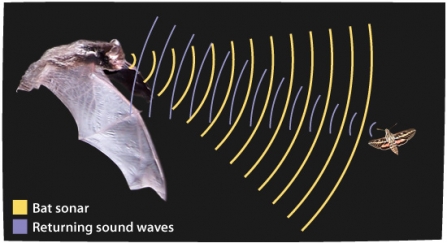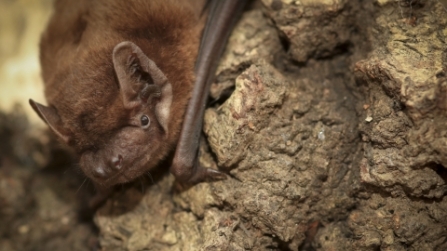All UK bats are insectivorous and they use echolocation to hunt prey and navigate their environment. They do this by producing ultrasonic calls, which bounce off objects and return to the bat's ears, providing them with spatial information about their environment. This allows them to build up an accurate picture of obstacles around them, giving them the ability to navigate cluttered environments and to accurately target their prey.
Identifying Bats from their Calls

A diagram showing how bat calls reflect off objects and return to the bat, providing spatial information to the bat. Source: Arizona State University
Each bat species has a different call, and therefore can be identified by studying call characteristics including: frequency, sound quality and duration. This allows ecologists to study bat activity without disturbing their behaviour.
Here are some examples of bat call types:
Pipistrelles
Pipistrelles are a well known group of bats which can be found in a wide variety of habitats. There are three species in the UK: common, soprano and Nathusius'. Each has a similar call shape, but emits with a different peak frequency:
Common pipistrelle: 45kHz
Soprano pipistrelle: 55kHz
Nathusius' pipistrelle 40kHz
A screenshot from Sonobat software showing a hockey stick shaped common pipistrelle call

©Tom Marshall
Big Bats
This group includes the noctule, serotine and Leisler's bat. These species produce the same call types as the pipistrelles, but echolocate at lower peak frequencies: usually between 20 and 30kHz.
The noctule and Leisler's bat often produce calls with a "chip-chop" sound, caused by the alternation of call types.
A screenshot from Sonobat software showing a noctule call. Noctules are the largest British bat and also produce the lowest frequency calls.

Daubenton's Bat © Dale Sutton 2020VISION
Myotis Bats
There are six Myotis species found in the UK: Natterer's bat, Daubenton's bat, Whiskered bat, Bechstein's bat, Brandt's bat and Alcathoe bat. Their calls are frequency modulated, and usually sweep through a wide range of frequencies. It is usually difficult to identify a peak frequency in these species, so other characteristics are used to identify them such as the quality of the call or the range the call sweeps through.
A screenshot from Sonobat software showing a Myotis bat call.

